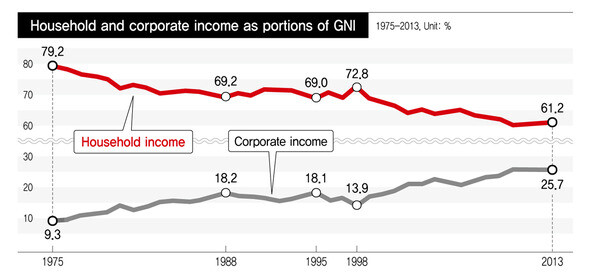hankyoreh
Links to other country sites 다른 나라 사이트 링크
Workers’ share of gross national income still below its peak of 17 years ago

Over the past 60 years, South Korea’s gross national income (GNI) has grown 30,000-fold, while the GNI per capita has multiplied 394 times over the same period. But the share of GNI represented by household income has fallen steadily since the 1970s, while the portion accounted for by corporate income has jumped around 300%.
In 1996, right before the Asian financial crisis, the labor share (workers’ wages as a percentage of the national income) was 62.4%, an all-time high. But in the 17 years since then, the labor share has failed to return to that mark. In short, more of the benefits of economic growth have gone to big corporations than to households.
According to “Results of Reorganizing the National Account (1953-1999),” released by the Bank of Korea on Dec. 15, South Korea’s GNI grew 29,833 times in the past 60 years, from 48.3 billion won in 1953 to 1,441 trillion won last year. Over the same period, per capita GNI jumped from US$67 to US$26,205, an average annual increase of 10.5% over 60 years.
During the 1970s, for example, the price of goods rose by 18.7%, and per capita GNI by 22.7%, on average each year.
As a result of this rapid economic growth, South Korea’s GNI rank jumped from 39th in the world in 1970 to 14th in 2012. Meanwhile, per capita GNI rose from 125th to 42nd.
But while GNI was soaring, families were taking home a decreasing percentage of that income, and corporations’ share shot up after the Asian financial crisis in 1997.
In 1975, when the South Korean government began tracking income statistics for different actors in the economy, household income accounted for 79.2% of GNI. Since then, that percentage has traced a steady downward arc, shrinking to 61.2% in 2013.
Since 1999, the percentage of household income has not surpassed 70% even once, and it has been stuck around 60-61% for four years since 2010.
In contrast, the share of corporate income rose from 9.3% in 1975 to 25.7% last year. During the same period, the public sector’s share showed a slight increase from 9.3% to 13.1%.
These trends in the percentage of household income and corporate income mean that improvement of household living standards has not kept up with growth in GNI over the past 40 years. It can be inferred that the operating profits from companies took the lead in the growth in GNI amid rapid growth in the corporate sector, while wages and profit from household assets have not increased as fast.
“The profitability of the corporate sector used to be sluggish, but there has been a major improvement in this area,” explained a source at the Bank of Korea.
The reduction in the household sector (compared with the corporate sector) can also be confirmed from the labor share of income. Labor’s share of national income, which had been as low as 27.3% in 1953, had been rising steadily after that point, reaching 62.4% in 1996, just before the Asian financial crisis.
As South Korea‘s industrial structure developed from an agricultural to a manufacturing base, there was a rapid increase in the number of labor-intensive jobs, leading naturally to growth in the labor share.
But the growth in labor share was halted after the Asian financial crisis in 1997 as companies implemented restructuring plans that led to increased employment of irregular workers, who are paid less. By 2000, labor share had fallen to 57.8%.
Labor share has been gradually increasing in the four years since 2010, but in 2013, it was 61.4%, still 1 percentage point shy of the previous record.
With sluggish growth in household income, the household saving rate plunged from its peak of 24.4% in 1988 to 4.5% in 2013, which is basically the same as the rate 60 years ago of 4.6%.
By Kim Su-heon, staff reporter
Please direct questions or comments to [english@hani.co.kr]

Editorial・opinion
![[Editorial] Perilous stakes of Trump’s rhetoric around US troop pullout from Korea [Editorial] Perilous stakes of Trump’s rhetoric around US troop pullout from Korea](https://flexible.img.hani.co.kr/flexible/normal/500/300/imgdb/original/2024/0509/221715238827911.jpg) [Editorial] Perilous stakes of Trump’s rhetoric around US troop pullout from Korea
[Editorial] Perilous stakes of Trump’s rhetoric around US troop pullout from Korea![[Guest essay] Preventing Korean Peninsula from becoming front line of new cold war [Guest essay] Preventing Korean Peninsula from becoming front line of new cold war](https://flexible.img.hani.co.kr/flexible/normal/500/300/imgdb/original/2024/0507/7217150679227807.jpg) [Guest essay] Preventing Korean Peninsula from becoming front line of new cold war
[Guest essay] Preventing Korean Peninsula from becoming front line of new cold war- [Column] The state is back — but is it in business?
- [Column] Life on our Trisolaris
- [Editorial] Penalties for airing allegations against Korea’s first lady endanger free press
- [Editorial] Yoon must halt procurement of SM-3 interceptor missiles
- [Guest essay] Maybe Korea’s rapid population decline is an opportunity, not a crisis
- [Column] Can Yoon steer diplomacy with Russia, China back on track?
- [Column] Season 2 of special prosecutor probe may be coming to Korea soon
- [Column] Park Geun-hye déjà vu in Yoon Suk-yeol
Most viewed articles
- 1[Editorial] Perilous stakes of Trump’s rhetoric around US troop pullout from Korea
- 2Nuclear South Korea? The hidden implication of hints at US troop withdrawal
- 3Behind-the-times gender change regulations leave trans Koreans in the lurch
- 4‘Free Palestine!’: Anti-war protest wave comes to Korean campuses
- 5[Photo] ‘End the genocide in Gaza’: Students in Korea join global anti-war protest wave
- 6In Yoon’s Korea, a government ‘of, by and for prosecutors,’ says civic group
- 7Korean president’s jailed mother-in-law approved for parole
- 8[Guest essay] Preventing Korean Peninsula from becoming front line of new cold war
- 9AI is catching up with humans at a ‘shocking’ rate
- 10Dermatology, plastic surgery drove record medical tourism to Korea in 2023